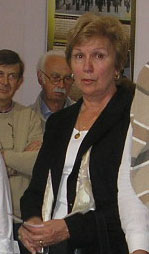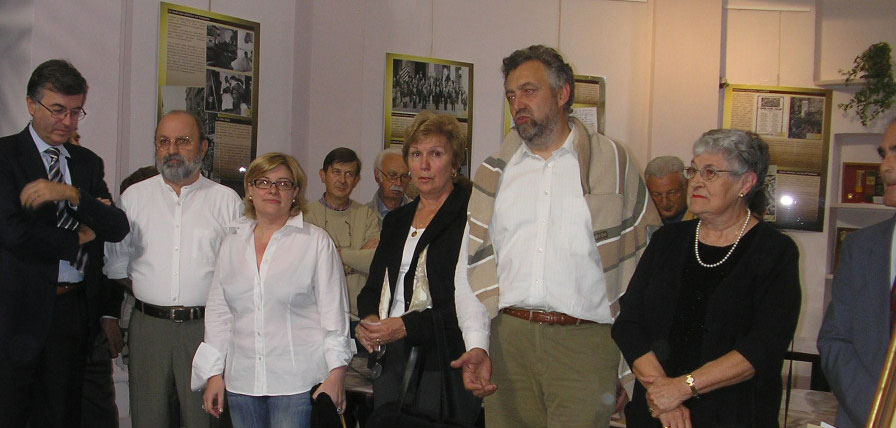Caroline Stelzer
Caroline Stelzer ha inaugurato la mostra sull’emigrazione che ha avuto luogo a Cuggiono
nella sede dell’Ecoistituto della Valle del Ticino, vai San Rocco 45, ex chiesa di S. Maria in Braida.
Alla vita che t'arride
Di speranze e gaudio piena,
D'altre mille e mille vite
Il destino s'incatena!
Te perduto, ov'è la patria
Col suo splendido avvenir
( Renato : Ballo in Maschera di Giuseppe Verdi)
Caroline Ranzini Stelzer rappresenta l’ideale della trasformazione avvenuta nei nostri emigranti durante il loro nuovo processo di vita nei vari mondi. Cresciuta nel quartiere a prevalenza lombardo della Hill, la cosiddetta Montagna di St.Louis, Missouri, è riuscita ad equilibrare la sua esistenza amalgamando la cultura italiana con quella americana. Nipote di emigranti da Castelletto di Cuggiono non ha mai dovuto ricercare le proprie radici perché non ha mai avuto bisogno di nasconderle. Si è scoperta forte nell’essere americana di discendenza italiana e la simbiosi delle due appartenenze ha avuto un apporto positivo. Niente perdita di identità, ma trasformazione. Jack, il marito americano ha accentuato maggiormente la sua italianità, in quanto, la parte italiana non è stata annullata e quella americana di Jack ha rappresentato soltanto una scelta personale. I figli e i nipoti cresciuti in America, lontano un tempo dall’Italia, sono americani. Era inevitabile. Inutile chiedersi perché non parlano italiano, perché non capiscono il valore dell’Italia. Tante domande. Quelle che magari non facciamo ai veneti o ai siciliani nati a Milano che non conoscono né la lingua né la terra dei padri. E’ inevitabile. Si studia e alla fine, la cultura, la conoscenza sono ciò che resta dopo questo processo. Ma americani di discendenza italiana, questo sì. E non è come si vuol far credere soltanto un cognome, un piatto particolare, oppure un viaggio al paese dei nonni.
Quei nonni che magari non hanno mai conosciuto e che non hanno potuto raccontare la loro vita ai nipoti. Pensieri sull’emigrazione. Barcamenarsi per sopravvivere. Ed allora, che cosa conta perdere la lingua di un paese che ti ha costretto in qualche modo ad andar via. Qualcuno si avvinghia al passato, ma a volte sia il presente sia il futuro sono più facili quando ci si adegua. Funzionalità.
Poi,un giorno, tutti questi ragionamenti arrivano ad un bivio. Qualcuno lascia perdere, ma per molti scatta il meccanismo delle introspezioni, delle ricerche di identità. Gli americani ne hanno fatto una ragione di vita, altrimenti non avrebbero senso i siti di genealogia, tutta la documentazione che si può rintracciare su tutto e su tutti o quasi. Questo desiderio di mettere le mani su un passato che sfugge, ma che fa parte della vita. Quest’ansia di dare una risposta al fatto di essere a St. Louis piuttosto che a Cuggiono.
Sulla Hill il rito di passaggio è stato meno doloroso e tragico che per altri. Il gruppo diventato comunità attorno alla chiesa, alle chiese italiane ha retto all’urto. Magari non ha raggiunto in fretta il sogno economico americano, ma ha mantenuto un equilibrio che è rimasto intatto nei figli e nei nipoti che continuano ad osservare la vita con valori diversi, soprattutto in relazione alla famiglia, all’educazione e la lavoro. E i nuovi americani di origine italiana si stanno ulteriormente trasformando perché molti quartieri si sono disgregati oppure, come nel caso della Hill, arrivano nuove persone estranee che però sono desiderosi di aderire al suo modello di vita..
A Cuggiono si cerca di capire chi sono questi americani, i discendenti di coloro che a centinaia andarono a costruire un altro tessuto sociale in America. Li abbiamo visti in aprte, in parte conosciuti, studiati.
Una mostra a Cuggiono, nella sede dell’Ecoistituto della valle del Ticino cerca ancora di gettare un ponte. Un ponte storico e robusto come quello di Eads sul Mississippi a St. Louis. Caroline racconta che il nonno Gerolamo Rossi lavorò alla sua costruzione addirittura nel 1873.
Una mostra a Cuggiono con i resti di una storia in transito. Pannelli esplicativi, giornali, riviste, fotografie, coccarde di varie associazioni, certificati di matrimonio, naturalizzazioni, miniere. Frammenti di vite poco narrate.
Caroline Ranzini Stelzer affiancata da Gloria Griffero. Testimoni di un tempo, artefici di una storia sempre poco raccontata. Donne di valore. Donne che hanno tramandato. Le Rose.
Folla intensa, pronta a capire. Fili da riannodare. Dollari con il bollino blu. Capire e non comprendere. Sindaco senza la fascia tricolore questa volta, ma con il ricordo di St. Louis dentro.
Le parole di Renato dal Ballo in Maschera di Verdi.
Caroline con la voce rotta dall’emozione nel rivolgersi a chi si aspetta un fluido.
Addii strazianti, definitivi, lunghi. Gare St. Lazare. Le Havre. Illinois Central. Trasferte infinite. Pianti prima della gioia. Alba. Alba. Tutto scorre davanti lentamente in dissolvenza.
Poi le parole sincopate di Caroline si spargono lungo la navata per propagarsi su tutta Cuggiono :
.
Siete voi la patria splendida e qui stanno le anime dei nostri emigranti e anche le nostre anime
Ernesto R Milani copyright
ernesto.milani 'at' gmail.com
8 ottobre 2007

Caroline Ranzini Stelzer represents embodies the ideal of the transformation that has occurred to our migrants during their new life process in ten various parts of the world. She grew up in the mostly Lombard neighborhood of the Hill, the so called Montagna in St. Louis, Missouri and she has managed to balance her existence by amalgamating the Italians and American culture. She is the niece of migrants from Castelletto di Cuggiono and she has never searched for her roots because she has never felt the urge to hide them. She has realized to be strong by being an American of Italian descent and the symbiosis of the two belongings has proved positive. No loss of identity but rather transformation. Jack her American husband has enhanced her Italianness since her Italian heritage has not been erased and Jack’s American ones has been a personal choice. Her children and grand-children have grown up in America, once so far away from Italy, are American. It was inevitable. It’s no use asking why they don’t speak Italian, why they don’t understand the value of Italy. Questions. Many questions. The same we ask perhaps the Veneti or the Sicilians born in Milano who ignore the language and the land of their fathers. Again, inevitable. People study and at the end, culture and knowledge are what remains after this process. However, Americans of Italian descent, yea, they are. And it’s not only a surname, a particular dish or a trip to the village where the grandparents were born as some claim. The same grandparents they never met and who had no chance to tell the story of their life to their grandchildren. Thought about migration. Learning how to survive. And then what is worth loosing the language of a country that has forced you to flee. Some cling to the past but sometimes the present and the future are easier when one adapts to the new situation. Functionality. The, one day, all this reasoning reaches cross-roads. Some people just let go, other trigger the mechanism of introspection and search of identity. American have fully embraced them, otherwise the numberless genealogy website would be meaningless, all the documentation you can find about almost everything and everybody. This desire to put one’s hands over a past that is running away but which is a part of life. This anxiety to answer the fact of living in St. Louis rather than Cuggiono.
On the hill the rite of passage has been less painful and tragic than others. The group turned community around the church, the Italian churches has hold up. Maybe it didn’t easily attained the economic American dream but it has maintained a balance which has remained intact in their children and grandchildren, who continue to observe life with different values most of all in relation to the family, upbringing and work. And the new American of Italian descent are continually transforming because many neighborhoods have broken up or as in the case of the Hill more newcomers settle there with a will to adopt its way of life.
Cuggiono tries to understand these Americans, the descendants of the hundreds who left to build another social environment in America. We have seen them in part, we have known them in part, and we have studied them in part.
In Cuggiono, an exhibit in Cuggiono in the new premises of the Ecoistituto della valle del Ticino attempt to throw a bridge. A historical and sturdy one like the Eads Bridge over the Mississippi in St. Louis. Caroline tells me that her grandfather Gerolamo Rossi was there in 1873 working at its construction.
An exhibit in Cuggiono with the remnants of a history in transit. Explicative frames, newspapers, magazines, photographs, badges of various fraternal orders, marriage certificates, naturalization records, mines. Fragment of nearly untold lives.
Caroline Ranzini Stelzer and Gloria Griffero. Witnesses of an era, makers of a seldom narrated history. Women of valiance. Women who have handed down their heritage. Roses. Thick crowd, ready to understand. Ties to be re-established. Dollars with the blue mark. Understanding and not comprehending. Mayor this time without the band, but inside recalling St. Louis. The words of Renato in Il Ballo in Maschera. by Verdi.
Caroline and her broken voice overwhelmed by her emotion while addressing who is waiting for a fluid.
Agonizing farewells. Final farewells. Long farewells. Gare St. Lazare. Le Havre. Illinois Central. Endless transfers. Crying before joy. Dawn. Dawn. Everything flowing in dissolution in front of the eyes.
Then Caroline’s’ syncopated words scatter along the nave and propagate all over Cuggiono :
You are my splendid homeland and here lie the souls of our migrants and also our souls.
Ernesto R Milani ©
ernesto.milani 'at' gmail.com
